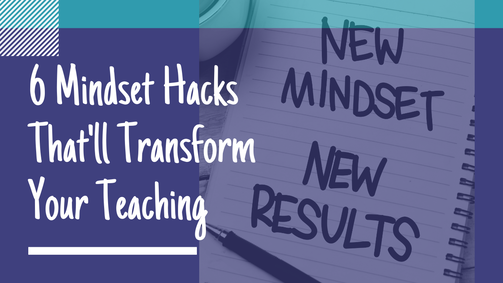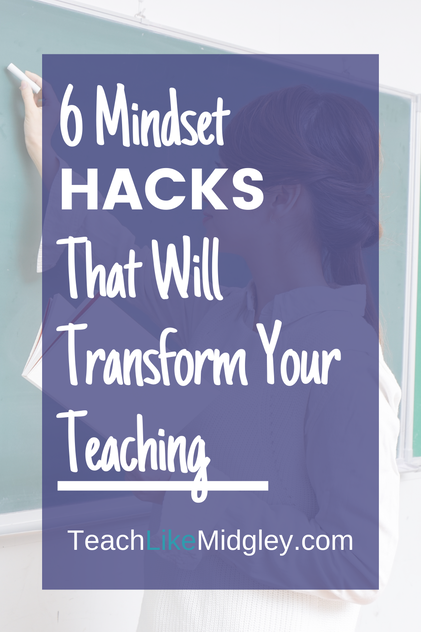6 Mindset Hacks That Will Transform Your Teaching
Does mindset really affect your teaching? Does it really affect student learning?
When we hear about teacher mindset, the first thought is usually connected to the concept of fixed and growth mindset. But your mindset is so much more than that.
Your mindset is the framework within which your mind thinks, associates, perceives, interprets, and reacts to situations.
Your mindset can be positive, negative, and everything between.
Your mindset is also responsible for how you respond to situations. Your thoughts, actions, behaviors, emotions, feelings, and choices are all determined by your mindset.
When we hear about teacher mindset, the first thought is usually connected to the concept of fixed and growth mindset. But your mindset is so much more than that.
Your mindset is the framework within which your mind thinks, associates, perceives, interprets, and reacts to situations.
Your mindset can be positive, negative, and everything between.
Your mindset is also responsible for how you respond to situations. Your thoughts, actions, behaviors, emotions, feelings, and choices are all determined by your mindset.
Why Your Mindset is Important
Your mindset is the basis for how you will interpret and react to a situation.
While your mindset will determine your thoughts and experience, a change in your mindset can then change your thoughts and your experience.
If you want to be happy and excited for a new opportunity, then you will be. If you want to be miserable with a change you can’t control, then you will be miserable.
If you have decided you don’t like a group of students, then your relationship will reflect that dislike.
While your mindset will determine your thoughts and experience, a change in your mindset can then change your thoughts and your experience.
If you want to be happy and excited for a new opportunity, then you will be. If you want to be miserable with a change you can’t control, then you will be miserable.
If you have decided you don’t like a group of students, then your relationship will reflect that dislike.
How Your Mindset is a Valuable Tool
How you choose to direct your thoughts, will directly affect how you feel about a situation.
If you’re like me, then you may be thinking that mindset is a bunch of hoopla and can’t possibly have that big of an impact. Because I definitely have felt this way before.
But the more you focus on your mindset, the more you will surely see its power.
If you’re like me, then you may be thinking that mindset is a bunch of hoopla and can’t possibly have that big of an impact. Because I definitely have felt this way before.
But the more you focus on your mindset, the more you will surely see its power.
Growth vs Fixed Mindset
Fostering a growth mindset in the classroom is a fundamental key to academic success.
According to psychologists at Stanford and Columbia Universities, how you think about intelligence can affect your success in school.
Generally, those students who believe that intelligence can be developed and improved do better in school than students who believe that intelligence is fixed – something you can’t change.
According to psychologists at Stanford and Columbia Universities, how you think about intelligence can affect your success in school.
Generally, those students who believe that intelligence can be developed and improved do better in school than students who believe that intelligence is fixed – something you can’t change.
Why Your Mindset Influences Students
Everything we do influences our students. Our comments, our attitude, our habits, and even our mindset.
As teachers we have an enormous amount of power over our students. As students are watching our every move, they are learning from us. They adopt our attitude, our habits, and repeat our comments.
When we model productive habits, we are teaching our students how to find success.
When we model our reflective thinking and thought processes, we are modeling for our students how to do the same.
It is just as important for us to model healthy mindset practices, as it is for us to model a new concept or academic skill.
As teachers we have an enormous amount of power over our students. As students are watching our every move, they are learning from us. They adopt our attitude, our habits, and repeat our comments.
When we model productive habits, we are teaching our students how to find success.
When we model our reflective thinking and thought processes, we are modeling for our students how to do the same.
It is just as important for us to model healthy mindset practices, as it is for us to model a new concept or academic skill.
How to Model Mindset for Students
Here are six easy ways we can begin modeling healthy mindset for students.
#1 Brain Dump
A great way to start your day is with a brain dump or a quick write. Have students take 5 minutes to write down what they’re anxious about, what they are excited about, and what needs to get done for the day. While they write, you write also – this is key for modeling. This exercise will help ease emotions and help everyone get in gear for the day.
#2 Review Goals Regularly
As a class, you should set goals. Goals for the school year, goals for the quarter, goals for your current unit. But most importantly, you need to revisit your goals and review your progress. As a class, review your goals regularly and discuss your progress. This will help you remember what you’re working towards and provide motivation to do what’s important.
#3 Block Your Time
This strategy is very effective during “work time” for students. Before you begin a work session, talk through what needs to get done and how much time should be given for each task. Remember that this is a learning exercise, so as you assign a time frame, be sure to revisit after the time is up. If students need more time, model for them how to reflect and adjust in order to keep moving forward.
#4 Learn from Failures
Growth mindset embraces learning, and that includes learning from mistakes, difficult circumstances, and failures.
In your classroom, students need to see you handle failure, so they will know how to handle it for themselves. This means you must share your thought process with them. When something doesn’t work the way you thought it would, share this with your students. Talk it out together and find a way to learn from it.
#5 Limit Technology
While technology can be an amazing teaching tool, it can also be a drain. Be sure to focus the energy in your classroom on creating and exploring.
When students see that the adults in their lives aren’t glued to a screen, they will be less likely to do the same.
#6 Positive Self-Talk and Affirmations
Self-talk is everything. If reflects beliefs you have about yourself, and whatever you believe eventually becomes your reality.
This hold especially true for students. One comment, good or bad, can have a powerful effect on how they see themselves.
This is why as teachers, it’s so important to change your vocabulary to fit your mindset. Start by removing words like can’t, don’t, not able, and never.
#1 Brain Dump
A great way to start your day is with a brain dump or a quick write. Have students take 5 minutes to write down what they’re anxious about, what they are excited about, and what needs to get done for the day. While they write, you write also – this is key for modeling. This exercise will help ease emotions and help everyone get in gear for the day.
#2 Review Goals Regularly
As a class, you should set goals. Goals for the school year, goals for the quarter, goals for your current unit. But most importantly, you need to revisit your goals and review your progress. As a class, review your goals regularly and discuss your progress. This will help you remember what you’re working towards and provide motivation to do what’s important.
#3 Block Your Time
This strategy is very effective during “work time” for students. Before you begin a work session, talk through what needs to get done and how much time should be given for each task. Remember that this is a learning exercise, so as you assign a time frame, be sure to revisit after the time is up. If students need more time, model for them how to reflect and adjust in order to keep moving forward.
#4 Learn from Failures
Growth mindset embraces learning, and that includes learning from mistakes, difficult circumstances, and failures.
In your classroom, students need to see you handle failure, so they will know how to handle it for themselves. This means you must share your thought process with them. When something doesn’t work the way you thought it would, share this with your students. Talk it out together and find a way to learn from it.
#5 Limit Technology
While technology can be an amazing teaching tool, it can also be a drain. Be sure to focus the energy in your classroom on creating and exploring.
When students see that the adults in their lives aren’t glued to a screen, they will be less likely to do the same.
#6 Positive Self-Talk and Affirmations
Self-talk is everything. If reflects beliefs you have about yourself, and whatever you believe eventually becomes your reality.
This hold especially true for students. One comment, good or bad, can have a powerful effect on how they see themselves.
This is why as teachers, it’s so important to change your vocabulary to fit your mindset. Start by removing words like can’t, don’t, not able, and never.
Final Thoughts...
Be sure to take the time to deep dive into your own mindset. It is difficult to model a healthy mindset for students when you don’t know where you currently stand.
Things to consider: what are your beliefs about mindset? Do you focus on effort as opposed to end result? How do you approach challenges? How do you handle mistakes? How do you handle feedback? And what type of feedback are you providing your students?
Things to consider: what are your beliefs about mindset? Do you focus on effort as opposed to end result? How do you approach challenges? How do you handle mistakes? How do you handle feedback? And what type of feedback are you providing your students?
This post was originally written by Hillary Midgley and published at Study Skills Unleashed
You May Also Like...
Let's Connect...

Welcome! I'm Hillary Midgley, a veteran 6th grade teacher.
I create educational materials and develop curriculum for other teachers. I specialize in teaching students how to learn through my Study Skills Curriculum. I have established fundamental classroom systems and structures for teachers to help them streamline their classroom. And my passion is teaching ancient history through engaging activities with foundations in academic skills. Here you will find resources on all of these topics and more. Learn more about me here.
|






